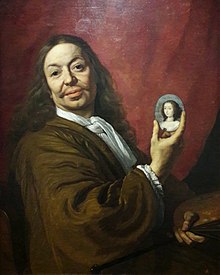Bartholomeus van der Helst
| Bartholomeus van der Helst | |
|---|---|

Self-portrait with a palette and a miniature of Princess Mary Henrietta of Orange (c. 1667), Muzeum Narodowe, Warsaw
|
|
| Born | 1613 Haarlem |
| Died | 1670 (buried 16 December) Amsterdam |
| Nationality | Dutch |
| Known for | Portrait painting |
| Notable work | Banquet of the Amsterdam Civic Guard in Celebration of the Peace of Münster |
Bartholomeus van der Helst (1613 – buried 16 December 1670) was a Dutch Golden Age portrait painter.
Born in Haarlem, the son of a Haarlem innkeeper, Van der Helst moved to Amsterdam some time before 1636, for in that year he married there Anna du Pire, of a prosperous family from Southern Netherlands. His first dated picture, a group portrait of the regents of the Walloon Orphanage (currently the location of Maison Descartes in Amsterdam), dates from 1637. It is unknown from whom he learned to paint, but in Haarlem he must have at least known the work of Frans Hals, who like him, never traveled to Italy and specialized in portraiture. Hals refused even to travel to Amsterdam to paint the lucrative schuttersstukken, and a few years after the trekschuit made commuting to Amsterdam possible in 1632 he attempted this in 1636 with the De Magere Compagnie, but gave it up and let Pieter Codde finish it. As the son of an innkeeper with ever-increasing trekschuit patrons, van der Helst would have seen immediately the importance of this and the relative value of Amsterdam above Haarlem. In any case, he moved to Amsterdam and in 1639 he won his own schutterstuk commission, The company of Captain Roelof Bicker and Lieutenant Jan Michielsz Blaeuw. In Amsterdam he may well have trained with Nicolaes Eliaszoon Pickenoy.
In Amsterdam Van der Helst was a contemporary of Rembrandt. He soon became the most popular painter of portraits in that city, his flattering portrayals in the style of Anthony van Dyck being more immediately appealing than Rembrandt's dark and introspective later work. Some of Rembrandt's pupils, including Ferdinand Bol and Govaert Flinck, adopted Van Helst's style instead of their master's.
...
Wikipedia
